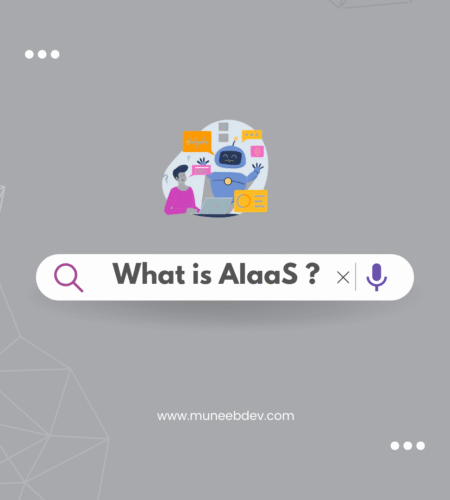What is AIaaS (Artificial Intelligence as a Service)?
AIaaS is a cloud-based service model that offers artificial intelligence tools and capabilities as a service. It allows individuals or organizations to access and implement AI without needing deep technical expertise or investing heavily in hardware and development.
Just like SaaS (Software as a Service), AIaaS provides AI functionalities over the internet through APIs, SDKs, or prebuilt tools.
Core Capabilities of AIaaS
- Machine Learning Platforms
- Train and deploy machine learning models.
- Example: Amazon SageMaker, Google Vertex AI
- Natural Language Processing (NLP)
- Understand, analyze, and generate human language.
- Example: OpenAI’s GPT-4 (used in ChatGPT)
- Computer Vision
- Recognize and interpret visual information.
- Example: Google Cloud Vision, Amazon Rekognition
- Speech Recognition
- Convert spoken language into text.
- Example: Azure Speech to Text, Google Speech AI
- Chatbots and Virtual Agents
- Automate customer support or interactions.
- Example: IBM Watson Assistant, Dialogflow
Benefits of AIaaS
| Benefit | Description |
|---|---|
| Cost Efficiency | No need to build and maintain AI infrastructure. |
| Scalability | Easily handle growing workloads and users. |
| Speed to Market | Deploy AI solutions faster with prebuilt APIs. |
| Accessibility | Makes advanced AI tools available to non-experts. |
| Customization | Many providers allow model fine-tuning on your own data. |
Real-Life Example: Netflix
Problem:
Netflix needed to enhance its recommendation engine to ensure users stayed engaged by watching more relevant content.
AIaaS Solution:
Netflix uses a combination of AWS AI and ML tools, including Amazon SageMaker, to run large-scale machine learning models. These models analyze:
- Viewing history
- User preferences
- Time of day
- Device used
Result:
The AIaaS-based recommendation engine contributes to over 80% of the content watched on the platform, significantly reducing churn and increasing watch time.
Case Study: H&M – Using AIaaS for Supply Chain Optimization
Background:
H&M, one of the world’s largest fashion retailers, needed to optimize inventory management to reduce overstock and understock issues across thousands of stores globally.
Challenge:
- Predict consumer demand for different regions
- Reduce unsold inventory and logistical costs
AIaaS Implementation:
H&M used Google Cloud’s AI and analytics platform to:
- Analyze data from customer transactions, store traffic, and weather.
- Apply machine learning models to forecast product demand per store.
- Integrate insights into their supply chain system.
Results:
- Reduced inventory waste by up to 21% in pilot regions.
- Increased sales by ensuring availability of in-demand products.
- Improved overall efficiency and agility in operations.
Top AIaaS Providers & Their Offerings
| Provider | Services |
|---|---|
| OpenAI | GPT, Codex, DALL·E, Whisper (via API) |
| AWS | Amazon Rekognition, Lex, SageMaker |
| Google Cloud | Vertex AI, Dialogflow, Vision AI |
| Microsoft Azure | Cognitive Services (NLP, vision, speech), Azure ML |
| IBM Watson | Assistant, NLP, Discovery |
AIaaS vs SaaS: A Clear Comparison
| Feature | SaaS | AIaaS |
|---|---|---|
| Definition | Software delivered over the internet for general business functions. | AI tools and models delivered via the cloud to integrate AI into applications. |
| Purpose | Solve business needs like email, CRM, accounting, project management. | Enable AI features like ML, NLP, image/speech recognition, etc. |
| End User | Typically non-technical business users. | Developers, data scientists, or companies looking to integrate AI. |
| Example Use Cases | Email (Gmail), CRM (Salesforce), Docs (Google Workspace) | Chatbots, recommendation engines, fraud detection, image analysis |
| Customization | Limited; uses standard features as-is. | High; users can train or fine-tune AI models with their data. |
| Interaction Level | Simple user interface (UI), minimal coding. | Typically API/SDK-based, requires some coding or technical knowledge. |
| Examples | Dropbox, Trello, Zoom, HubSpot | OpenAI, AWS SageMaker, Azure Cognitive Services, Google Vertex AI |
Real-World Analogy
- SaaS is like buying a ready-made car: You get a complete, working product designed to serve a specific purpose.
- AIaaS is like renting an AI-powered engine: You still have to build or integrate the rest of the vehicle (your app), but the engine gives it powerful capabilities (like voice recognition, predictions, etc.).
Example to Illustrate the Difference
Let’s say you run an e-commerce website:
- Using SaaS:
You subscribe to Shopify (a SaaS platform) to manage your store, process payments, and handle logistics — all via a UI. - Using AIaaS:
You integrate OpenAI’s GPT API to create a product recommendation chatbot or summarize customer reviews. You’re not using a full UI solution — you’re embedding intelligence into your custom solution.
Can They Work Together?
Yes! Many SaaS products integrate AIaaS under the hood. For example:
- Salesforce (SaaS) uses Einstein AI (AIaaS) for predictive analytics.
- Grammarly (SaaS) uses NLP models to enhance writing suggestions.
Final Thoughts
AIaaS is democratizing AI by making it more accessible, affordable, and scalable. Whether you’re a startup building a chatbot or a multinational optimizing operations, AIaaS allows you to tap into powerful AI tech without reinventing the wheel.


Comments